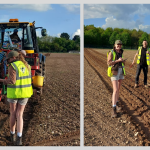Blog #3 Vibrant energy in the vineyards!
As we can safely say, summer is now here and the vineyards are alive with vibrant energy! I am excited to share with you my experiences and insights from this captivating season in the vineyard.
Recently, I had the opportunity to attend the Groundswell agriculture show, a gathering that left me inspired and eager to explore new horizons in the world of viticulture. The event provided a platform to listen to thought-provoking talks, engage with fascinating individuals in the industry, and delve deeper into the world of regenerative agriculture and its huge impact on our environment.
Regenerative viticulture is a topic of utmost importance in today’s wine industry. It encompasses practices that go beyond organics and sustainability, aiming to restore and enhance the health of our vineyards and the surrounding ecosystems. It is an approach that recognises the interconnectedness of all elements within the vineyard, from soil health to biodiversity, and seeks to create a harmonious and resilient environment for the vines to thrive.
At Vinescapes, we understand the significance of regenerative viticulture and have made it an integral part of our services. We believe that by adopting regenerative practices, we can create vineyards that not only produce exceptional wines but also contribute positively to the environment and the communities they are a part of.
Through our services, we strive to educate and support our clients in implementing regenerative practices. This includes soil conservation, cover cropping, rotational grazing, and the integration of native plant species to enhance biodiversity. We work closely with vineyard owners and managers, providing them with the knowledge and tools to cultivate healthy vineyards that can withstand the challenges of climate change and promote long-term sustainability.
Regenerative viticulture not only benefits the environment but also has the potential to enhance the quality and character of the wines produced. By nurturing the health of the soil, improving water management, and promoting natural pest control, we can create an environment in which the vines can express their true potential, resulting in wines that are a true reflection of their terroir.
Let’s delve deeper into viticulture practices during the phenological season, exploring some key aspects and their importance in the vineyard;
Shoot selection on young vines: For younger vines, shoot selection is one of the most vital practices during the first few years of its life, it will determine the vines longevity.
It entails carefully choosing well-positioned and vigorous shoots, while removing excessive or weak ones. This helps with creating a clear and direct sap flow to the future trunk. Correct shoot selection promotes balanced vine growth, enhances fruit quality, and lays the foundation for the future productivity of the vineyard.
Disease and Pest Management: The growing season is a critical time for monitoring and managing diseases and pests which pose significant threats to the vines. Regular monitoring and timely intervention are essential to prevent and manage issues such as powdery mildew, downy mildew, and insect infestations, such as Spotted Wing Drosophila (SWD), aphids and grapevine moth. By identifying potential issues early on, we can implement Integrated Pest Management (IPM) practices, which involve the use of beneficial insects, natural predators, and targeted treatments, help maintain a healthy vineyard ecosystem while minimizing the use of chemical interventions.
Canopy Management: During the summer, the vines enter the phenological growing season, characterised by vigorous growth and the development of leaves and shoots. Canopy management plays a crucial role during this time. It involves practices such as shoot thinning, correct leaf removal, and hedging or braiding to ensure optimal sunlight exposure, airflow, and disease prevention. Proper canopy management helps regulate vine vigour, promotes even ripening of the constituents of grapes, and reduces the risk of fungal diseases.
Yield Forecasting: During the phenological growing season, it becomes important to estimate the potential yield of the vineyard. Yield forecasting involves assessing the number and size of grape clusters, as well as considering factors such as vine vigour and crop load. By closely monitoring vine development and estimating the yield, vineyard managers can make informed decisions regarding crop load management, harvest timing, and resource allocation.
Green Harvesting: Green harvesting, also known as crop thinning or cluster thinning, is a practice carried out during the phenological growing season. It involves the removal of excess grape clusters to achieve balanced vine growth, optimise grape quality, and maintain desired yields. Green harvesting ensures that the vine’s resources are channelled efficiently, resulting in concentrated constituents and improved grape maturity.
Monitoring and Data Recording: Continuous monitoring and data recording are vital during the phenological growing season. This includes recording temperature and humidity levels, monitoring vine growth, and regularly inspecting grape clusters for quality and ripeness. These practices require attention to detail, regular vineyard walks, and a deep understanding of vine behaviour and health. All providing valuable insights for decision-making, such as determining the optimal time for harvest or adjusting vineyard management practices to meet specific goals.
As we navigate through this somewhat challenging season, it is crucial to approach these practices with a balance of knowledge, experience, and sensitivity to the unique characteristics of each vineyard. By implementing sustainable viticulture practices and prioritising the long-term health and resilience of the vines, we can create vineyards that truly reflect the unique terroir of the vineyard.
Incorporating regenerative viticulture principles in these practices further enhances their positive impact on the environment and the long-term sustainability of the vineyard. For example, by promoting biodiversity in the vineyard, such as planting cover crops or creating habitat for beneficial insects, pest and disease pressures can be naturally mitigated. This reduces the reliance on chemical interventions and fosters a healthier vineyard ecosystem with healthier soils.
So, let’s raise a glass to the vineyards and the intricate dance between the vine, the terroir, and the skilled hands that guide them. Stay tuned for more insights and updates as we continue our journey through the fascinating world of viticulture. Cheers to a successful and fruitful season ahead!






